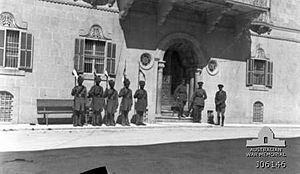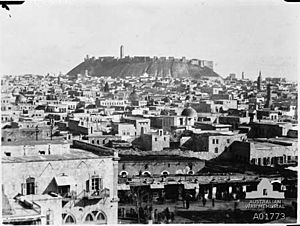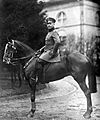Pursuit to Haritan facts for kids
Quick facts for kids Pursuit to Haritan |
|||||||
|---|---|---|---|---|---|---|---|
| Part of the Middle Eastern theatre of World War I | |||||||
 Desert Mounted Corps headquarters at Aleppo |
|||||||
|
|||||||
| Belligerents | |||||||
|
|||||||
| Commanders and leaders | |||||||
| Units involved | |||||||
| XXI Corps Desert Mounted Corps |
Remnants of the Fourth Army Seventh Army Eighth Army Asia Corps |
||||||
The Pursuit to Haritan was a military operation during the final weeks of World War I in the Middle East. It happened between September and October 1918. British Empire forces, including soldiers from Australia, New Zealand, and India, chased the retreating Ottoman (Turkish) and German armies.
This pursuit started after the city of Damascus was captured on October 1, 1918. The goal was to push the enemy further north. The British forces advanced from Haifa and Acre along the coast. They captured important ports like Beirut and Tripoli. This allowed them to get supplies for their troops moving inland.
Meanwhile, the cavalry (soldiers on horseback) pushed deep into enemy territory. They captured towns like Homs and Hama. Prince Feisal's Arab forces also helped. They attacked and captured the city of Aleppo on October 25-26. The pursuit ended near Haritan on October 26, after a final battle where the Ottoman forces withdrew.
Contents
Why the Pursuit Happened
After the Battle of Megiddo
The pursuit happened right after a big victory called the Battle of Megiddo. This battle took place on September 25, 1918. The Ottoman army was badly defeated and had to retreat.
General Edmund Allenby, who led the British forces, ordered his cavalry to chase the retreating enemy. This chase was led by Lieutenant General Henry Chauvel's Desert Mounted Corps.
Chasing the Enemy
The cavalry divisions split up to pursue the enemy. The Australian Mounted Division went through Kuneitra. The 4th Cavalry Division went inland to the Hejaz railway. They met up with Prince Feisal's Arab forces.
Along the way, the British and Arab forces attacked several enemy rearguards. These were small groups of enemy soldiers left behind to slow down the chase. Battles happened at places like Irbid and Kiswe.
Supplying the Troops
As the British cavalry moved further north, it became harder to get supplies. Their supply lines were getting very long. The Ottoman army, however, was getting closer to their main bases.
To solve this, General Allenby planned to capture coastal cities. These cities had ports where supplies could be brought in by ship. This was a smart way to keep the troops fed and equipped.
Coastal Advance to Beirut and Tripoli
Marching to Beirut
The British 7th (Meerut) Division started marching from Haifa on September 29. Their goal was to capture Beirut. The road along the coast was very difficult. It was narrow and steep in places.
Engineers had to work hard to improve the road. This allowed wheeled vehicles to pass. But the cavalry could move faster. They reached Tyre on October 4 and Sidon on October 6. Supplies were sent to these ports by sea.
Capturing Beirut
Beirut was a large city with an important port. It was mostly Christian. British armored cars were the first to arrive on October 7. They found that the Ottoman forces had already left. An Arab government had been set up in the city.
The British XXI Corps cavalry arrived on October 8. They occupied Beirut without a fight. They captured about 600 prisoners. The rest of the infantry and artillery followed when the road was ready.
Moving to Tripoli
On October 9, General Allenby ordered his troops to quickly capture Tripoli. This city and its port were also very important. Supplies could be unloaded there and sent inland to Homs. This would greatly help the pursuit.
Tripoli was captured without a fight on October 13. Armored cars and cavalry led the way. The rest of the 7th (Meerut) Division arrived later. Capturing Tripoli made it much easier to supply the cavalry pushing inland.
Inland Pursuit from Damascus
Ottoman Retreat from Rayak
After an air attack on Rayak, the Ottoman commander, Liman von Sanders, pulled his troops out on October 2. Most of his soldiers, including the Asia Corps, went to Aleppo. They planned to set up a defense there.
About 19,000 Ottoman soldiers had retreated north by October 1. But only about 4,000 of them were still able to fight. They had low morale and very little equipment. They were not in a good state to fight the British cavalry.
Cavalry Chase Continues
The British chase north from Damascus started again on October 5. The 4th and 5th Cavalry Divisions moved towards Rayak. They had to leave their wheeled transport and guns behind at first.
A big storm hit them on the march. This made things even harder, especially with many soldiers getting sick. But they reached Rayak on October 6. They found that the Ottomans had destroyed a lot of things there, including German aircraft.
Reaching Baalbek
The advance continued to Baalbek. This city was captured without a fight on October 10. It was an important step in the chase towards Homs.
However, the 4th Cavalry Division started having serious problems. Many soldiers became very sick with malaria and influenza. Almost 80% of the soldiers were ill. This meant the division could not continue fighting.
The 5th Cavalry Division Pushes On
The 5th Cavalry Division was not as badly affected by sickness. So, they continued the pursuit. General MacAndrew, their commander, reorganized them into two groups. They had armored cars and machine guns.
Prince Feisal's Arab forces also helped. They advanced alongside the cavalry, protecting their right side. They moved towards Homs and Hama.
Capturing Homs and Hama
The Ottoman Fourth Army tried to hold Homs for as long as possible. But on October 16, the British armored cars and cavalry, along with Arab forces, captured the city.
The British forces continued their push. They reached Hama, a city of 60,000 people. Hama was captured by Prince Feisal's Arab forces before October 20.
Air Support for the Chase
Airplanes from No. 1 Squadron, Australian Flying Corps helped a lot. They flew long distances to patrol and scout. They bombed enemy airfields and railway stations.
For example, on October 2, they bombed Rayak. They saw 32 German planes that had been abandoned or burned. They also attacked trains at Homs and Hama. This air support was very important for the fast-moving cavalry.
The Capture of Aleppo
Aleppo's Importance
Aleppo was an ancient city, about 200 miles north of Damascus. It was very important because it had a key railway junction. This junction connected the railway systems from Palestine and Mesopotamia.
Mustapha Kemal, an Ottoman commander, had gathered about 6,000 to 7,000 soldiers to defend Aleppo.
Fighting for Aleppo
On October 23, British armored cars reached the southern defenses of Aleppo. They demanded that Mustapha Kemal surrender the city, but he refused.
Prince Feisal's Arab forces, led by Nuri Bey, attacked Aleppo on the night of October 25-26. After a tough fight in the city streets, they successfully captured Aleppo.
The Final Push to Haritan
Battle at Haritan
After Aleppo was captured, the remaining Ottoman forces moved north. On October 26, the British 15th Imperial Service Cavalry Brigade continued the pursuit. They advanced towards Haritan, northwest of Aleppo.
The Mysore Lancers, part of the 15th Brigade, charged an Ottoman rearguard. They captured some prisoners. But the Ottoman position was quickly reinforced by many more soldiers, possibly up to 2,000, led by Mustapha Kemal.
The fighting continued all day. Later that night, more British cavalry arrived. The strong Ottoman rearguard finally withdrew further north. This was the last major battle of the war in the Middle East.
Australian Mounted Division Arrives
The Australian Mounted Division was ordered to advance and support the 5th Cavalry Division at Aleppo. They marched out of Damascus on October 27. They rode about 156 miles in four days.
They reached Homs on November 1. There, they learned that the war against the Ottoman Empire was over.
The End of the War
Armistice Signed
The Armistice of Mudros was signed on October 30, 1918. This agreement officially ended the war between the Allies and the Ottoman Empire.
The news reached the troops quickly. Many were exhausted but relieved. The war in the Middle East had lasted for three years.
What Happened Next
The armistice had strict terms for the Ottoman Empire. Their army had to be demobilized (disbanded). All war vessels had to be surrendered. All Allied prisoners were to be released.
The British forces occupied the captured territories. General Allenby was in charge of the administration. The goal was to help the local people set up their own governments.
However, there were still disagreements about how the region would be divided. This led to more conflicts later on. The war had brought down an empire, but it also created new challenges for the future of the Middle East.
Images for kids
-
Krak des Chevaliers overlooking Homs


























